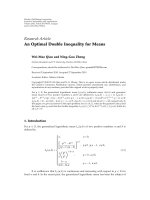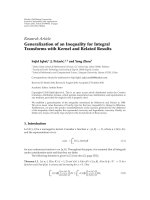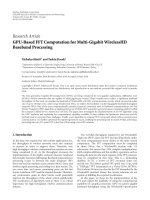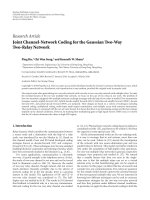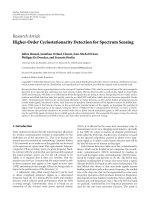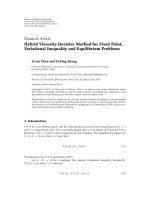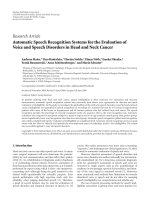Báo cáo hóa học: " Research Article Rate-Based Active Queue Management for TCP Flows over Wired and Wireless " potx
Bạn đang xem bản rút gọn của tài liệu. Xem và tải ngay bản đầy đủ của tài liệu tại đây (707.19 KB, 8 trang )
Hindawi Publishing Corporation
EURASIP Journal on Wireless Communications and Networking
Volume 2007, Article ID 54038, 8 pages
doi:10.1155/2007/54038
Research Article
Rate-Based Active Queue Management for
TCP Flows over Wired and Wireless Networks
Jun Wang and Min Song
Department of Electrical and Computer Engineering, Old Dominion University, 231 Kaufman Hall, Norfolk, VA 23529, USA
Received 21 July 2006; Revised 18 November 2006; Accepted 22 November 2006
Recommended by Xiuzhen Cheng
Current active queue management (AQM) and TCP protocol are designed and tuned to work well on wired networks where packet
loss is mainly due to network congestion. In wireless networks, however, communication links suffer from significant transmission
bit errors and handoff failures. As a result, the performance of TCP flows is significantly degraded. To mitigate this problem, we
analyze existing AQM schemes and propose a rate-based exponential AQM (REAQM) scheme. The proposed REAQM scheme
uses the input rate as a primary metric and queue length as the secondary metric. The objectives of REAQM are to stabilize net-
works with low packet loss, low packet delay, and high link utilization regardless the dynamic of network conditions. We prove
the global asymptotic stability of the equilibrium based on Lyapunov theory. Simulation results suggest that REAQM is capable of
performing well for TCP flows over both wired and wireless networks, and has comparable implementation complexity as other
AQM schemes.
Copyright © 2007 J. Wang and M. Song. This is an open access article distributed under the Creative Commons Attribution
License, which permits unrestricted use, distribution, and reproduction in any medium, provided the original work is properly
cited.
1. INTRODUCTION
The essence of network congestion control is that a sender
adjusts its transmission ra te according to the congestion
measure of the underline networks. There are two compo-
nents to accomplish this. One is a source algorithm that dy-
namically adjusts the transmission rate in response to the
congestion; the other one is a link algorithm that implicitly
or explicitly conveys information about the current conges-
tion measure to sources using that link. In the current In-
ternet, the source algorithm is carried out by TCP, and the
link algorithm is performed by active queue management
(AQM) schemes at routers. Examples of AQM schemes are
RED [1], REM [2], AVQ [3], and Yellow [4]. TCP defines how
the source rates are adjusted while AQM schemes define how
the congestion measure is defined and updated.
According to the t ype of metrics used to measure con-
gestion, AQM schemes can be classified into three catalog s:
queue-based, rate-based, and schemes based on concurrent
queue and rate metrics. In queue-based schemes, congestion
is observed by average or instantaneous queue length and the
control aim is to stabilize the queue length. The drawback of
queue-based schemes is that a backlog is inherently necessi-
tated. Rate-based schemes predict the utilization of the link,
determine the level of congestion, and take actions based on
the packet arrival rate. Rate-based schemes can provide early
feedback for congestion [3]. Other AQM schemes deploy a
combination of queue length and input rate to measure con-
gestion and achieve a tradeoff between queue stability and
responsiveness.
Current TCP/AQM algorithms assume that packet loss
is mainly due to network congestion. However, these TCP/
AQM algorithms are insufficient for the hybrid wired and
wireless networks. In wireless networks, communication
links have intrinsic characteristics that affect the perfor-
mance of transport protocols including variable bandwidth,
corruption, channel allocation delays, and asymmetry [5].
All of these cause significant noncongestion packet loss.
The generic TCP protocol notifies sources to reduce their
transmission rates only when facing packet losses due to
network congestion. Therefore, the TCP protocol in hy-
brid wired and wireless networks needs not only to detect
packet losses, but also to detect the reason of packet losses.
Moreover, the degree of statistical multiplexing number of
flows over wireless links is different from that over wired
links [5]. For example, a wireless link only has several flows
instead of hundreds of flows over a wired link. While existing
TCP/AQM schemes are tuned well for wired links which have
2 EURASIP Journal on Wireless Communications and Networking
high degree of statistical multiplexing, they may not work
well for wireless links with only several flows.
In this paper, we present a new rate-based exponen-
tial AQM (REAQM) with explicit congestion notification
(ECN) marking, and use REAQM to enhance the TCP per-
formance over wireless links. The main idea of REAQM is
to use the mismatch between input rate and link capacity as
the primary metric, which exploits the early feedback bene-
fit of rate-based marking. Furthermore, REAQM uses queue
length to compute a coefficientofratemismatchanduseit
as a secondary metric. The rationale of the secondary metric
is to achieve a tradeoff between queue stability and respon-
siveness of the system. Using ECN marking to notify senders
of incipient congestion, REAQM overcomes the packet loss
problem of burst data and errors over wireless links, and
also performs well for high degree of multiplex of flows over
wired links.
The rest of the paper is structured as follows. In Section 2,
we introduce some related work, including the analytical
model for TCP/AQM algorithms, the state-of-the-art re-
search results on AQM schemes, and the characteristics of
wireless links. We present the design of REAQM and analyt-
ical results in Section 3.InSection 4, we discuss simulation
design and results, and compare our REAQM scheme with
other AQM schemes. Finally, we provide concluding remarks
in Section 5.
2. RELATED WORK
We start this section by introducing three representative
AQM schemes. RED is a queue-based, most popular AQM
schemes used [1]. In RED, packets are randomly dropped
before the buffer is completely full, and the drop proba-
bility increases with the average queue length. As source
rates increase, queue length grows and more packets are
marked/dropped. This prompts the sources to reduce their
rates. RED configuration has been a problem since its first
proposal, and many studies have tried to address this issue
[6]. While the presence of a persistent queue indicates a con-
gestion, its length gives very little information as to the sever-
ity of congestion. Therefore, decoupling queue length from
congestion management has some benefits.
REM is a queue-and-rate-based scheme. The objective of
REM is to stabilize both the input rate around link capac-
ity and the queue length around a predetermined target, re-
gardless of the number of users sharing the link [2]. In REM,
each output queue maintains a price function as a congestion
measure. The price is updated based on rate mismatch (i.e.,
difference between input rate and link capacity) and queue
mismatch (i.e., difference between queue length and the pre-
determined target). Correspondingly, REM uses an exponen-
tial marking probability function. REM decouples conges-
tion measure f rom performance measure such as packet loss,
queue length, or packet delay. Since REM tries to maintain a
target queue length regardless the number of flows, it limits
its ability to handle burst traffic.
AVQ is primarily a rate-based scheme, as opposed to
queue length or average queue length-based marking [3, 7].
AVQ maintains a virtual queue whose capacity is less than the
actual capacit y of the link. When a packet arrives in the real
queue, the virtual queue is also updated to reflect the new
arrival. Packets in the real queue are marked/dropped w hen
the virtual buffer overflows. The virtual capacity at each link
is then adapted to ensure that each link achieves a desired
utilization of the link. Another rate-based scheme is called
Yello w [4]. Yellow uses the load utilization as a primary met-
ric to manage congestion, and a queue control function as
a secondary metric to improve congestion control perfor-
mance. According to Yellow, a load factor is calculated from
link incoming rate and virtual available capacity, where the
virtual available capacity is updated based on the queue con-
trol function. The queue control function is introduced to
achieve a stable and smooth response. The main idea of Yel-
low is to perform queue management based on the link load
factor, and to predict incipient congestion timely and accu-
rately with controlled queuing delays, stability, and robust-
ness. Packet marking probability is based on the load factor
to achieve hig h link utilization and avoid high packet loss ra-
tio.
Rate-based marking provides early feedback and re-
sponds fast wh en there exists a rate mismatch between in-
put rate and link capacity. The advantages of this approach
have been explored in [8]. The early feedback is more ro-
bust to the presence of extremely short flows or variability
in the number of long flows in the network. When utiliza-
tion is close to 100%, the variance introduced by short flows
seems to lead to an undesirable transient b ehavior where
excessively large queue lengths persist over long periods of
time. Since queue length is a cumulative difference value of
rate mismatch, queue metric is insensitive to current queue
arrival and drain rates. Low [7]proposedadualitymodel
for TCP/AQM algorithms to explain the equilibrium prop-
erties of a large network under TCP/AQM control, such as
throughput, delay, queue length, loss probability, and fair-
ness. Duality model considers the process of congestion con-
trol as a distributed computation by sources and links over a
network to solve a global optimization problem in real time.
Gurtov and Floyd [5] consider the interplay between
wireless links and transport protocols, and present the rules
to appropriately model wireless links. Wireless links suffer
from significant packet losses due to bit errors and handoffs.
A TCP flow can only reduce its sending rate on losses due to
network congestion, not on those due to wireless effects. New
AQM algorithms have been proposed specifically for wireless
links. Sagfors et al.use instantaneous queue length to mea-
sure congestion and propose a deterministic dropping strat-
egy, packet discard prevention counter, which is tailored to
an estimate of the pipe capacity and TCP’s rate halving pol-
icy [9]. Li and Liu present an explicit feedback scheme with
AQM to handle l arge bandwidth delay product and burst
packet losses over wireless links [10]. The main problem in
such scenarios is preventing the slow start overshoot of TCP
connections. The overshoot happens because TCP detects
congestion up to one RTT after filling the buffer and the first
packet drop. The TCP’s sending rate at this point can be twice
the available bandwidth of the path and thus generate many
packet drops.
J. Wang and M. Song 3
Most wireless networks suffer from bursty errors. A two-
state Markov error model is used to capture the packet loss
characteristics [11]. The two states represent a good state with
a low-bit-error-rate (BER) value and a bad state with a high
BER value. The link switches between good and bad states,
and the lifetime of each state is exponentially distributed with
adifferent mean value at each time. Moreover, the degree of
statistical multiplexing number of flows over wireless links is
different from that over wired links. For example, a wireless
link only has several flows instead of hundreds of flows over a
wired link. When the degree of statistical multiplexing is low
and the buffer size is small, existing AQM algorithms may
not perform sufficiently well. While many link technologies
include forward error correction (FEC) and local retransmis-
sion for addressing corruption at the link layer, these mecha-
nisms can introduce their own complications, and result in a
high variability of bandwidth and delay on wireless links.
3. REAQM SCHEME
3.1. Scheme description
The objectives of REAQM scheme are to regulate the link
utilization and stabilize the networking system regardless
the changing network conditions. Similar to REM, REAQM
maintains a variable, price, as a congestion measure and uses
an exponential marking probability funct ion. On the other
hand, REAQM differs from REM in the definition of conges-
tion measure. Denote p
l
(t) as the price at queue l in per iod t.
The marking probability function of REAQM is
m
l
(t) = 1 − φ
−p
l
(t)
,(1)
where φ is a constant larger than 1. The parameter φ deter-
mines the range of loss or marking probability, which also
depends on the range of price p
l
(t). Ideally, φ should be cho-
sen in a way that the end-to-end probability observed at hosts
is small, especially for the AIMD algorithm of TCP Reno and
its variants.
At each packet arrival epoch, the price is u pdated accord-
ing to the following equation:
p
l
(t +1)=
p
l
(t)+γ
f
q
l
(t)
y
l
(t) − c
l
+
. (2)
Here, p
l
(0) = 0, and [z]
+
= max{z,0}. q
l
(t) is the aggre-
gate queue length at queue l in period t, y
l
(t) is the aggregate
input rate to queue l in per iod t,andc
l
is the link capac-
ity at queue l. The smoothing parameter γ>0 is a step size
which determines the speed of convergence of the algor ithm.
Alargerγ results in a faster convergence, but it also incurs a
higher risk of oscillatory queue. The coefficient of rate mis-
match is a function of queue mismatch at queue l in period
t;
f
q
l
(t)
=
α
l
q
l
(t)
c
l
+1, (3)
where weight parameter, α
l
, is a constant. Obviously,
f (q
l
(t))≥1, and it is equal to 1 only if q
l
(t) =0. If the value of
α
l
is small, the queue length has less effect on the coefficient.
Substituting (3) into (2), we get
p
l
(t +1)=
p
l
(t)+γ
α
l
q
l
(t)
y
l
(t)
c
l
+ y
l
(t) − c
l
+
. (4)
Price is updated, periodically or asynchronously, mainly
based on rate mismatch. The price is incremented if rate mis-
matches is positive, and decremented otherwise. Rate mis-
match is positive when the input rate exceeds the link capac-
ity and negative otherwise. Queue length is used to compute
the coefficient of rate mismatch and adjust the scale of rate
mismatch. If queue length is small, the impact of rate mis-
match decreases and REAQM is less aggressive. Otherwise,
REAQM is more aggressive. The rationale behind price up-
date is that the smaller queue length, the more rate mismatch
is allowed. This makes a tradeoff between the system stabil-
ity and utilization. If current input rate exceeds link capac-
ity, the packet marking probability wil l increase; otherwise,
it will decrease. Second, the larger the current queue length,
the larger the coefficient of rate mismatch is; thus the larger
the price value increases or decreases as well. While rate mis-
match is positive, that is, y
l
(t) >c
l
, the price always increases
for any value of queue length. If α
l
is larger enough, fre-
quently positive rate mismatch results in a small queue size
and may lower system throughput. We modify the price up-
date equation in this case as
p
l
(t +1)=
p
l
(t)+γ
α
l
q
l
(t)
y
l
(t) − y
0
c
l
+ y
l
(t) − c
l
+
,
(5)
where y
0
is target queue length while rate mismatch is pos-
itive, and α
l
is relative weight parameter larger than α
l
.
REAQM has comparable implementation complexity as
REM, since the mainly difference of REAQM and REM is the
price function.
When the number of TCP flow increases, the rate mis-
matches grow and thus push up the price and hence mark-
ing probability. This increases the intensity of congestion sig-
nal to sources, which then reduce tra nsmission rates. When
transmission rates are too small, the mismatches will be neg-
ative. This lowers the price and marking probability and
raises transmission rates, until eventually the mismatches
are driven to zero yielding high utilization a nd negligible
loss and delay in equilibrium. Recall that the mean queue
length steadily increases as the number of flows increases in
RED. In contrast, the price steadily increases while rate mis-
matches grows and the mean queue length is stabilized under
REAQM.
Generally, ECN bit is used to inform the source which
losses are due to congestion or wireless effects [2, 7]. If a
packet is marked by setting its ECN bit, the mark is carried to
the destination and then conveyed back to the source via ac-
knowledgments. We set ECN bit to 1 while packets are prob-
abilistically marked a ccording REAQM scheme, and drop
packets only when they arrive at a full buffer. Although this
method cannot completely prevent buffer from overflowing
and thus some packets are dropped by congestion, it differ -
entiates most of error losses and congestion losses.
4 EURASIP Journal on Wireless Communications and Networking
We conclude this section by stating that AQM must be
more aggressive to avoid buffer overflow for high degree of
statistical multiplexing and less aggressive to avoid underuti-
lization for low degree of statistical multiplexing. Consider
a single link accessed by many TCP sources with the same
round-trip time (RTT). Assume fixed packet size and the link
is equally shared amongst n TCP long-live flows. A conges-
tion notification to one flow reduces the offered load by a
factor of (1
− 1/2n). Therefore, the larger n is, the less impact
of individual marking.
3.2. Stability analysis
In this section, we present a global stability analysis for
REAQM based on the duality model for TCP/AQM system
[7]. The global asymptotic stability of the equilibrium for
REAQM scheme can be proved based on Lasalle’s invariance
principle applied to a suitable Lyapunov function as in [12].
Let (q
∗
, p
∗
) be an equilibrium of our system, q
∗
s
and x
∗
s
be the equilibrium source price and rate for source s,respec-
tively. Further, let y
∗
l
be the equilibrium link rate for queue l.
The queue length is taken as follow:
q
l
(t +1)=
q
l
(t)+y
l
(t) − c
l
+
. (6)
From (2)and(6), the price and queue dynamic are taken
to be
˙
p
l
(t) =
⎧
⎨
⎩
γ
f
q
l
(t)
y
l
(t) − c
l
, p
l
(t) > 0,
γ
f
q
l
(t)
y
l
(t) − c
l
+
, p
l
(t) = 0,
˙
q
l
(t) =
⎧
⎨
⎩
y
l
(t) − c
l
, q
l
(t) > 0,
y
l
(t) − c
l
+
, q
l
(t) = 0.
(7)
Theorem 1. Given the system defined by (7), assume f
s
(q
s
) is
strictly decreasing in q
s
> 0 and that R is of full row rank, then
the unique equilibrium point q
∗
= 0, p
∗
is globally asymptot-
ically stable.
First, we introduce the candidate Lyapunov function
V(q, p):
V(q, p)
=
L
l=1
γα
l
q
2
l
2
+
c
l
− y
∗
l
p
l
+
S
s=1
φ
s
q
s
,(8)
where φ
s
(q
s
) =
q
s
q
∗
s
(x
∗
s
− f
s
(σ))dσ.FunctionV is nonnega-
tive and radially unbounded.
Take the derivative of V(q, p) along trajectories of our
system:
˙
V
=
L
l=1
γα
l
q
l
˙
q
l
+
c
l
− y
∗
l
˙
p
l
+
S
s=1
x
∗
s
− f
s
q
s
˙
q
s
. (9)
Thelasttermabovecanberewrittenas
S
s=1
x
∗
s
− f
s
q
s
˙
q
s
=
x
∗
− x
T
˙
q
=
x
∗
− x
T
R
T
˙
p
=
y
∗
− y
T
˙
p
=
L
l=1
y
∗
l
− y
l
˙
p
l
.
(10)
Substituting back, we have
˙
V
=
L
l=1
γα
l
q
l
˙
q
l
+
c
l
− y
l
˙
p
l
=
L
l=1
v
l
, (11)
where v
l
= γα
l
q
l
˙
q
l
+(c
l
− y
l
)
˙
p
l
.
We will show that
˙
V
≤ 0foreachl. We apply the dynamic
equation (7), and discuss the four cases:
(1) q
l
> 0, p
l
> 0. Here
v
l
= γα
l
q
l
y
l
− c
l
+
c
l
− y
l
γ
f
q
l
y
l
− c
l
=
γ
y
l
− c
l
α
l
q
l
−
f
q
l
y
l
− c
l
=
γ
y
l
− c
l
α
l
q
l
−
α
l
c
l
q
l
y
l
+ y
l
− c
l
=−
γ
α
l
q
l
c
l
+1
y
l
− c
l
2
=−γf
q
l
y
l
− c
l
2
.
(12)
(2) q
l
> 0, p
l
= 0. Here
v
l
=
y
l
− c
l
γα
l
q
l
−
γ
f
q
l
y
l
− c
l
+
. (13)
If [γ( f (q
l
)y
l
− c
l
)]
+
= 0, y
l
≤ c
l
/f(q
l
) <c
l
, v
l
=
γα
l
q
l
(y
l
− c
l
) < 0.
Note that f (q
l
) > 1 while q
l
> 0.
Otherwise,
v
l
=
y
l
− c
l
γα
l
q
l
− γ
f
q
l
y
l
− c
l
=−
γf
q
l
y
l
− c
l
2
.
(14)
(3) q
l
= 0, p
l
> 0. Here f (q
l
) = 1, so
v
l
=
c
l
− y
l
γ
f
q
l
y
l
− c
l
=−
γ
y
l
− c
l
2
. (15)
(4) q
l
= 0, p
l
= 0. Here f (q
l
) = 1, so
v
l
=
c
l
− y
l
γ
f
q
l
y
l
− c
l
+
=
c
l
− y
l
γ
y
l
− c
l
+
.
(16)
If y
l
− c
l
< 0, [γ(y
l
− c
l
)]
+
= 0, so v
l
= 0.
If y
l
− c
l
≥ 0, v
l
=−γ(y
l
− c
l
)
2
.
We thus confirm that v
l
≤ 0foreveryl,thus
˙
V ≤ 0. Based on
Lyapunov’s stability theorem, the trajectory (q(t), p(t)) must
remain bounded over the time, and the equilibrium point
(q
∗
, p
∗
) is stable in the sense of Lyapunov. Note that
˙
V = 0
when either y
l
− c
l
< 0, or y
l
− c
l
< 0andq
l
= p
l
= 0,
which is the desired stable zone. The set of states (q, p)where
the Lyapunov derivative is zero is as same as that in [12]. The
system is globally asymptotically stable by means of Lasalle’s
invariance principle.
4. SIMULATIONS AND ANALYSIS
Simulations are conduced using ns-2 simulator. Figure 1
shows the network topology, where n TCPflowsshareabot-
tleneck link that marks or drops packets according to some
AQM scheme.
J. Wang and M. Song 5
S
1
S
2
S
3
.
.
.
S
n
R
1
R
2
REAQM
gateway
D
1
D
2
D
3
.
.
.
D
n
Figure 1: Network topology.
In Figure 1, the two routers (R
1
and R
2
) are connected
by a link with a capacity of 10 Mbps, which could be a wired
or wireless link. The capacity of all other links is 100 Mbps.
The propagation delay of the bottleneck link (between two
routers) is set to be 10 milliseconds, and those of the other
links are set to be uniformly distributed between 10 millisec-
onds and 30 milliseconds. NewReno is used as default trans-
port protocol with the TCP data packet size 1000 bytes. The
performance metrics are average queue length, link utiliza-
tion, and packet loss ratio.
In the first experiment, we study the parameter setting of
REAQM, especially, for the parameters α
l
. We assume that
the bottleneck link is reliable and run the simulation for dif-
ferent number of TCP flows. We start the experiment with
50 FTP flows in the system, and new 50 FTP flows are added
every 50 seconds until the total number of fl ows reach 250.
The queue size is 50. The objective is to study the sensitiv-
ity for the parameter α
l
and the thumb of rule for parameter
configuration.
The performance influence of parameter α
l
is given in
Figure 2. The value of α
l
determines the prominence given
to the queue length when determining the level of conges-
tion. As can be seen the average queue length (Figure 2(a))is
reduced with increasing α
l
. The smaller α
l
is, the smaller the
coefficient of rate mismatch is. Therefore, queue length has
less effect on the rate mismatch. If only (4) is used, the price is
always increased with positive rate mismatch. While small α
l
is chosen, average queue length will be increased. The coeffi-
cient is small while we use small α
l
. The price increases lightly
even with large queue length and positive rate mismatch.
Eventually, it results in very large queue length. On the other
hand, large α
l
indicates that even a small queue length has
relative effect on the coefficient of rate mismatch. If both
the number of flows and α
l
are large enough, average queue
length is very small and link utilization is also low. Therefore,
price is updated based on (5) in the experiment. For the same
α
l
, average queue length decreases mostly while the number
of flows increases. The reason is larger number of flows re-
sults in a higher probability of positive rate mismatch, which
reduces the allowable queue length. It should be noticed that
packet loss r atio (Figure 2(b)) is increased lightly with in-
creasing α
l
.Fordifferent α
l
, the larger average queue length
is, the smaller packet loss ratio is. Therefore, choosing differ-
ent value of α
l
makes a tradeoff between queue length and
loss ratio. Packet loss r atio is increased with the increasing of
number of flows. Link utilization (Figure 2(c)) is very stable
0.05 0.07 0.09 0.11 0.13 0.15 0.17 0.19
α
l
25
30
35
40
45
50
Average queue length
n = 50
n
= 100
n
= 150
n
= 200
n
= 250
(a) Average queue length.
0.05 0.07 0.09 0.11 0.13 0.15 0.17 0.19
α
l
0.05
0.1
0.15
0.2
0.25
0.3
Packet loss ratio
n = 50
n
= 100
n
= 150
n
= 200
n
= 250
(b) Packet loss ratio.
0.05 0.07 0.09 0.11 0.13 0.15 0.17 0.19
α
l
0.944
0.946
0.948
0.95
0.952
0.954
0.956
Link utilization
n = 50
n
= 100
n
= 150
n
= 200
n
= 250
(c) Link utilization.
Figure 2: Performance using different α
l
.
6 EURASIP Journal on Wireless Communications and Networking
for all α
l
while the number of flows is larger than 50, and has
oscillation while number of flows is 50. We can use different
values of α
l
toachievesmallqueuelengthormaintainsmall
packet loss ratio.
In the follow ing experiments, we compare REAQM with
other AQM schemes over wired and wireless networks. In
these experiments, we use the “gentle” version of RED. The
parameters of REM were chosen as recommended in [2], and
the parameters of AVQ were chosen as recommended in [3].
The queue size is 50 for all AQM schemes. The parameters
of REAQM are set as follows: α
l
= 0.11, γ = 0.001, and
Φ
= 1.001.
In the second experiment, we consider the bottleneck
link is reliable, and FTP flows are added or dropped to the
network. We start the experiment with only small number of
FTP flows in the system, and new 50 FTP flows are added ev-
ery 50 seconds until the total number of flows reach the max-
imal value, 300. Then 50 flows are dropped every 50 seconds
until the total number of flows is e qual to the initial number.
For every 50 seconds, we calculate each performance metric.
A long transient period is always with an increasing average
queue length while new flows are added before the scheme is
able to converge at new network condition. Therefore, aver-
age queue length over each 50 seconds interval captures per-
sistent transients.
Figure 3 shows the performance of each AQM scheme
under varying degree of flow multiplexing over the wired
link. The overall performance of REAQM is comparable
with REM and RED. Average queue length (Figure 3(a))
of REAQM is comparable with that of REM, and is larger
than that of RED and AVQ. Packet loss ratio (Figure 3(b))
of REAQM is smaller than other schemes. Link utilization
(Figure 3(c)) of REAQM is comparable with that of REM,
and is higher than RED and AVQ. The average queue length
and link utilization of REAQM are also very stable for dif-
ferent number of flows. REAQM uses rate mismatch as
main metric to update the price, which makes it very ro-
bust to the present of variabilit y in the number of flows.
The performance of AVQ is different with other schemes.
It has the smallest average queue length and link utiliza-
tion.
In the third experiment, we compare the properties of
various AQM schemes while the bottleneck link is wireless.
We modify NewReno so that a source halves its window when
it receives a mark or detects a loss through timeout, but re-
transmits without halving its window when it detects a loss
through duplicate acknowledgments. The number of flows
added or dropped at each time interval is 10 due to the low
degree of flow multiplexing over w ireless link.
Figure 4 shows the performance of each AQM schemes
under varying degree of flow multiplexing over the wireless
link. The average queue length (Figure 4(a))ofREAQMis
slight smaller than that of REM, and higher than that of other
two schemes. Packet loss ratios (Figure 4(b)) of all schemes
are comparable. The link utilization (Figure 4(c))ofREAQM
and REM are better than RED and AVQ. While the number
of flows is small, link utilization of AVQ is lower than that of
other schemes.
0 50 100 150 200 250 300
n
0
10
20
30
40
Average queue length
REAQM
RED
REM
AVQ
(a) Average queue length.
0 50 100 150 200 250 300
n
0
0.05
0.1
0.15
0.2
0.25
Packet loss ratio
REAQM
RED
REM
AVQ
(b) Packet loss ratio.
0 50 100 150 200 250 300
n
0.91
0.92
0.93
0.94
0.95
Link utilization
REAQM
RED
REM
AVQ
(c) Link utilization.
Figure 3: Performance test versus number of FTP flows for the dif-
ferent AQM schemes over wired link.
J. Wang and M. Song 7
0 102030405060
n
0
5
10
15
20
25
30
35
Average queue length
REAQM
RED
REM
AVQ
(a) Average queue length.
0102030405060
n
0
0.02
0.04
0.06
0.08
0.1
0.12
Packet loss ratio
REAQM
RED
REM
AVQ
(b)Packetlossratio.
0102030405060
n
0.85
0.87
0.89
0.91
0.93
0.95
0.97
Link utilization
REAQM
RED
REM
AVQ
(c) Link utilization.
Figure 4: Performance test versus number of FTP flows for the dif-
ferent AQM schemes over wireless link.
5. CONCLUSIONS
In wireless networks, packets are lost mainly because of bit
errors and intermittent connectivity. In this paper, we have
presented a new rate-based exponential AQM (REAQM)
with explicit congestion notification (ECN) marking, and
use REAQM to enhance the TCP performance over both
wired and wireless links. The main idea of REAQM is to
use the mismatch between input rate and link capacity as
the primary metric, which exploits the early feedback bene-
fit of rate-based marking. Furthermore, REAQM uses queue
length to compute a coefficient of rate mismatch and uses it
as a secondary metric. The rationale of the secondary met-
ric is to achieve a tradeoff between queue stability and re-
sponsiveness of the system. The global asymptotic stability of
REAQM has been proved using Lyapunov theory. Simulation
results suggest that REAQM is capable of performing well
for TCP flows over both wired and wireless networks, and
has comparable implementation complexity as other AQM
schemes.
ACKNOWLEDGMENT
The research of Dr. Min Song is partially supported by
U.S. National Science Foundation (NSF) Career Award CNS-
0644247.
REFERENCES
[1] S. Floyd and V. Jacobson, “Random early detection gateways
for congestion avoidance,” IEEE/ACM Transactions on Net-
working, vol. 1, no. 4, pp. 397–413, 1993.
[2] S. Athuraliya, S. H. Low, V. H. Li, and Q. Yin, “REM: active
queue management,” IEEE Network, vol. 15, no. 3, pp. 48–53,
2001.
[3] S. S. Kunniyur and R. Srikant, “An adaptive virtual queue
(AVQ) algorithm for active queue management,” IEEE/ACM
Transactions on Networking, vol. 12, no. 2, pp. 286–299, 2004.
[4]C.Long,B.Zhao,X.Guan,andJ.Yang,“Theyellowactive
queue management algorithm,” Computer Networks, vol. 47,
no. 4, pp. 525–550, 2005.
[5] A. Gurtov and S. Floyd, “Modeling wireless links for trans-
port protocols,” ACM SIGCOMM Computer Communication
Review, vol. 34, no. 2, pp. 85–96, 2004.
[6] H. Ohsaki and M. Murata, “Steady state analysis of the RED
gateway: stability, transient behavior, and parameter setting,”
IEICE Transactions on Communications,vol.E85-B,no.1,pp.
107–115, 2002.
[7] S. H. Low, “A duality model of TCP and queue management
algorithms,” IEEE/ACM Transactions on Networking, vol. 11,
no. 4, pp. 525–536, 2003.
[8] S.DebandR.Srikant,“Rate-basedversusqueue-basedmod-
els of congestion control,” in Proceedings of Joint International
Conference on Measurement and Modeling of Computer Systems
(SIGMETRICS /Performance ’04), pp. 246–257, New York, NY,
USA, June 2004.
[9] M.Sagfors,R.Ludwig,M.Meyer,andJ.Peisa,“Queueman-
agement for TCP traffic over 3G links,” in Proceedings of
IEEE Wireless Communications and Networking Conference
(WCNC ’03), vol. 3, pp. 1663–1668, New Orleans, La, USA,
March 2003.
8 EURASIP Journal on Wireless Communications and Networking
[10] V. H. Li and Z Q. Liu, “PET: enhancing TCP performance
over3G&beyondnetworks,”inProceedings of the 58th IEEE
Vehicular Technology Conference (VTC ’03), vol. 4, pp. 2302–
2306, Orlando, Fla, USA, October 2004.
[11] H. Wang and N. Moayeri, “Finite-state Markov channel—a
useful model for radio communication channels,” IEEE Trans-
actions on Vehicular Technolog y , vol. 44, no. 1, pp. 163–171,
1995.
[12] F. Paganini, “A global stability result in network flow control,”
Systems and Control Letters, vol. 46, no. 3, pp. 165–172, 2002.

